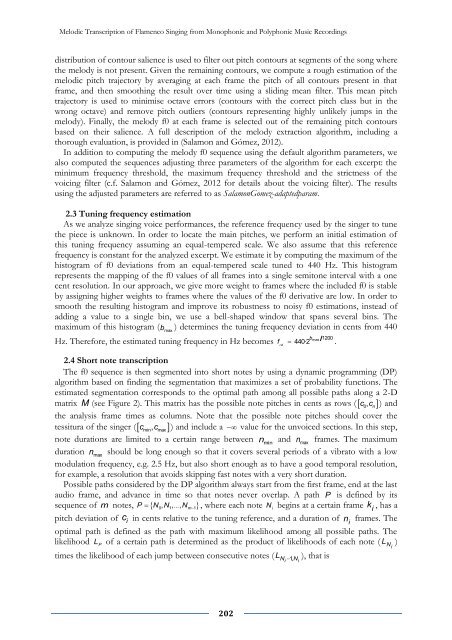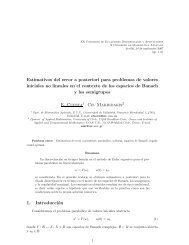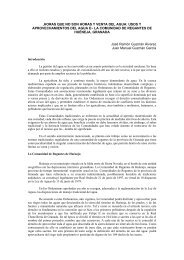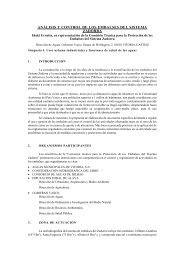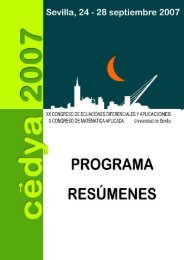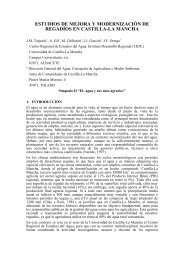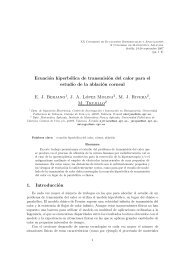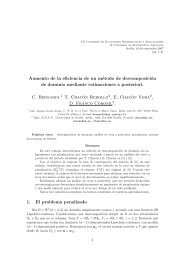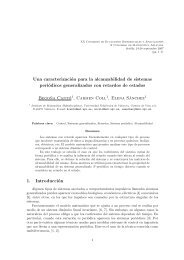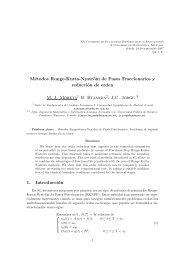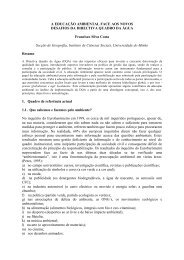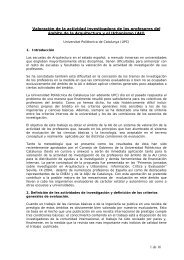LIBRO DE ACTAS (pdf) - Universidad de Sevilla
LIBRO DE ACTAS (pdf) - Universidad de Sevilla
LIBRO DE ACTAS (pdf) - Universidad de Sevilla
You also want an ePaper? Increase the reach of your titles
YUMPU automatically turns print PDFs into web optimized ePapers that Google loves.
Melodic Transcription of Flamenco Singing from Monophonic and Polyphonic Music Recordings<br />
distribution of contour salience is used to filter out pitch contours at segments of the song where<br />
the melody is not present. Given the remaining contours, we compute a rough estimation of the<br />
melodic pitch trajectory by averaging at each frame the pitch of all contours present in that<br />
frame, and then smoothing the result over time using a sliding mean filter. This mean pitch<br />
trajectory is used to minimise octave errors (contours with the correct pitch class but in the<br />
wrong octave) and remove pitch outliers (contours representing highly unlikely jumps in the<br />
melody). Finally, the melody f0 at each frame is selected out of the remaining pitch contours<br />
based on their salience. A full <strong>de</strong>scription of the melody extraction algorithm, including a<br />
thorough evaluation, is provi<strong>de</strong>d in (Salamon and Gómez, 2012).<br />
In addition to computing the melody f0 sequence using the <strong>de</strong>fault algorithm parameters, we<br />
also computed the sequences adjusting three parameters of the algorithm for each excerpt: the<br />
minimum frequency threshold, the maximum frequency threshold and the strictness of the<br />
voicing filter (c.f. Salamon and Gómez, 2012 for <strong>de</strong>tails about the voicing filter). The results<br />
using the adjusted parameters are referred to as SalamonGomez-adaptedparam.<br />
2.3 Tuning frequency estimation<br />
As we analyze singing voice performances, the reference frequency used by the singer to tune<br />
the piece is unknown. In or<strong>de</strong>r to locate the main pitches, we perform an initial estimation of<br />
this tuning frequency assuming an equal-tempered scale. We also assume that this reference<br />
frequency is constant for the analyzed excerpt. We estimate it by computing the maximum of the<br />
histogram of f0 <strong>de</strong>viations from an equal-tempered scale tuned to 440 Hz. This histogram<br />
represents the mapping of the f0 values of all frames into a single semitone interval with a one<br />
cent resolution. In our approach, we give more weight to frames where the inclu<strong>de</strong>d f0 is stable<br />
by assigning higher weights to frames where the values of the f0 <strong>de</strong>rivative are low. In or<strong>de</strong>r to<br />
smooth the resulting histogram and improve its robustness to noisy f0 estimations, instead of<br />
adding a value to a single bin, we use a bell-shaped window that spans several bins. The<br />
maximum of this histogram ( b ) <strong>de</strong>termines the tuning frequency <strong>de</strong>viation in cents from 440<br />
max<br />
max Hz. Therefore, the estimated tuning frequency in Hz becomes 1200 b<br />
440·2<br />
202<br />
f .<br />
2.4 Short note transcription<br />
The f0 sequence is then segmented into short notes by using a dynamic programming (DP)<br />
algorithm based on finding the segmentation that maximizes a set of probability functions. The<br />
estimated segmentation corresponds to the optimal path among all possible paths along a 2-D<br />
matrix M (see Figure 2). This matrix has the possible note pitches in cents as rows (c0, c n)<br />
and<br />
the analysis frame times as columns. Note that the possible note pitches should cover the<br />
tessitura of the singer (cmin, c max )<br />
and inclu<strong>de</strong> a value for the unvoiced sections. In this step,<br />
note durations are limited to a certain range between n and min n frames. The maximum<br />
max<br />
duration n max should be long enough so that it covers several periods of a vibrato with a low<br />
modulation frequency, e.g. 2.5 Hz, but also short enough as to have a good temporal resolution,<br />
for example, a resolution that avoids skipping fast notes with a very short duration.<br />
Possible paths consi<strong>de</strong>red by the DP algorithm always start from the first frame, end at the last<br />
audio frame, and advance in time so that notes never overlap. A path P is <strong>de</strong>fined by its<br />
sequence of m notes, P N0, N1, ... , Nm1 , where each note N i begins at a certain frame k<br />
i , has a<br />
pitch <strong>de</strong>viation of i c in cents relative to the tuning reference, and a duration of n frames. The<br />
i<br />
optimal path is <strong>de</strong>fined as the path with maximum likelihood among all possible paths. The<br />
likelihood L P of a certain path is <strong>de</strong>termined as the product of likelihoods of each note ( L )<br />
times the likelihood of each jump between consecutive notes ( LN 1, N ), that is<br />
ref<br />
i i<br />
Ni


